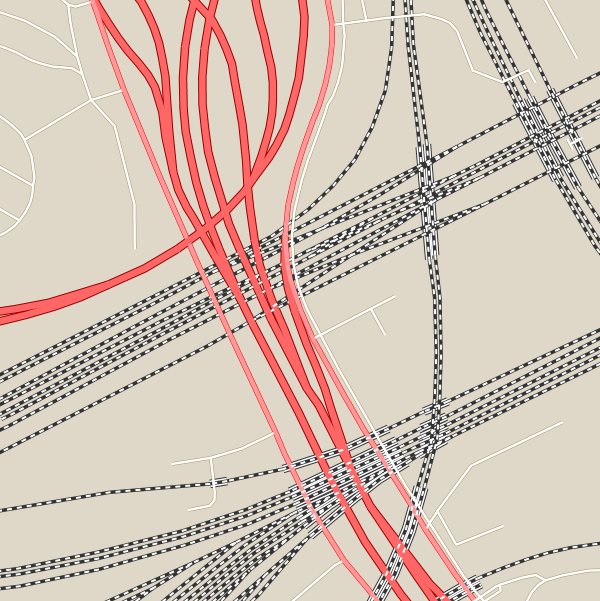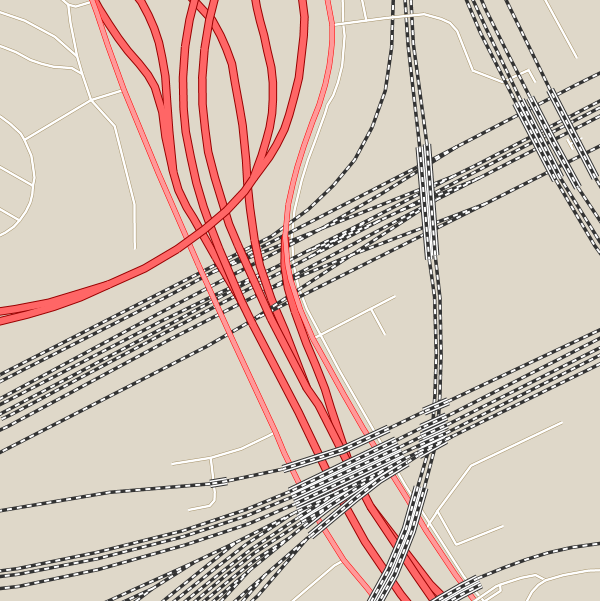Enabling z-ordering in a single FeatureTypeStyle¶
The z-ordering is implemented as a new FeatureTypeStyle vendor option, sortBy, which controls
in which order the features are extracted from the data source, and thus painted.
The sortBy syntax is the same as the WFS one, that is, a list of comma separated field names,
with an optional direction modifier (ascending being the default):
field1 [A|D], field2 [A|D], ... , fieldN [A|D]
Some examples:
“z”: sorts the features based on the
zfield, ascending (lower z values are painted first, higher later)“cat,z D”: sorts the features on the
catattribute, with ascending order, and for those that have the samecatvalue, the sorting is on descendingz“cat D,z D”: sorts the features on the
catattribute, with descending order, and for those that have the samecatvalue, the sorting is on descendingz
So, if we wanted to order features based on a single “elevation” attribute we’d be using the following SLD snippet:
...
<sld:FeatureTypeStyle>
<sld:Rule>
...
<!-- filters and symbolizers here -->
...
</sld:Rule>
<sld:VendorOption name="sortBy">elevation</sld:VendorOption>
</sld:FeatureTypeStyle>
...
z-ordering across FeatureTypeStyle¶
It is a common need to perform road casing against a complex road network, which can have its own
z-ordering needs (e.g., over and under passes).
Casing is normally achieved by using two separate two FeatureTypeStyle, one drawing a thick
line, one drawing a thin one.
Let’s consider a simple data set, made of just three roads:
_=geom:LineString:404000,z:int
Line.1=LINESTRING(0 4, 10 4)|1
Line.2=LINESTRING(0 6, 10 6)|3
Line.3=LINESTRING(7 0, 7 10)|1
Adding a “sortBy” rule to both FeatureTypeStyle objects will achieve no visible result:
<?xml version="1.0" encoding="ISO-8859-1"?>
<StyledLayerDescriptor version="1.0.0"
xsi:schemaLocation="http://www.opengis.net/sld StyledLayerDescriptor.xsd"
xmlns="http://www.opengis.net/sld" xmlns:ogc="http://www.opengis.net/ogc"
xmlns:xlink="http://www.w3.org/1999/xlink" xmlns:xsi="http://www.w3.org/2001/XMLSchema-instance">
<!-- a named layer is the basic building block of an sld document -->
<NamedLayer>
<UserStyle>
<FeatureTypeStyle>
<Rule>
<LineSymbolizer>
<Stroke>
<CssParameter name="stroke">#FF0000</CssParameter>
<CssParameter name="stroke-width">8</CssParameter>
</Stroke>
</LineSymbolizer>
</Rule>
<sld:VendorOption name="sortBy">z</sld:VendorOption>
</FeatureTypeStyle>
<FeatureTypeStyle>
<Rule>
<LineSymbolizer>
<Stroke>
<CssParameter name="stroke">#FFFFFF</CssParameter>
<CssParameter name="stroke-width">6</CssParameter>
</Stroke>
</LineSymbolizer>
</Rule>
<sld:VendorOption name="sortBy">z</sld:VendorOption>
</FeatureTypeStyle>
</UserStyle>
</NamedLayer>
</StyledLayerDescriptor>
The result will be the following:

This is happening because while the roads are loaded in the right order, Line.1,Line.3,Line.2,
they are all painted with the tick link first, and then the code will start over, and paint
them all with the thin line.
In order to get both casing and z-ordering to work a new vendor option, sortByGroup, needs to
be added to both FeatureTypeStyle, grouping them in a single z-ordering paint.
<?xml version="1.0" encoding="ISO-8859-1"?>
<StyledLayerDescriptor version="1.0.0"
xsi:schemaLocation="http://www.opengis.net/sld StyledLayerDescriptor.xsd"
xmlns="http://www.opengis.net/sld" xmlns:ogc="http://www.opengis.net/ogc"
xmlns:xlink="http://www.w3.org/1999/xlink" xmlns:xsi="http://www.w3.org/2001/XMLSchema-instance">
<!-- a named layer is the basic building block of an sld document -->
<NamedLayer>
<UserStyle>
<FeatureTypeStyle>
<Rule>
<LineSymbolizer>
<Stroke>
<CssParameter name="stroke">#FF0000</CssParameter>
<CssParameter name="stroke-width">8</CssParameter>
</Stroke>
</LineSymbolizer>
</Rule>
<sld:VendorOption name="sortBy">z</sld:VendorOption>
<sld:VendorOption name="sortByGroup">roads</sld:VendorOption>
</FeatureTypeStyle>
<FeatureTypeStyle>
<Rule>
<LineSymbolizer>
<Stroke>
<CssParameter name="stroke">#FFFFFF</CssParameter>
<CssParameter name="stroke-width">6</CssParameter>
</Stroke>
</LineSymbolizer>
</Rule>
<sld:VendorOption name="sortBy">z</sld:VendorOption>
<sld:VendorOption name="sortByGroup">roads</sld:VendorOption>
</FeatureTypeStyle>
</UserStyle>
</NamedLayer>
</StyledLayerDescriptor>
The result will be the following:

When grouping is used, the code will first paint Line.1,Line3 with the thick line, then track back
and paint them with the thin line, then move to paint Line.2 with the thick line, and finally
Line.2 with the thin line, achieving the desired result.
z-ordering across layers¶
Different layers, such for example roads and rails, can have their features z-ordered together
by putting all the FeatureTypeStyle in their styles in the same sortByGroup, provided
the following conditions are met:
The layers are side by side in the WMS request/layer group. In other words, the z-ordering allows to break the WMS specified order only if the layers are directly subsequent in the request. This can be extended to any number of layers, provided the progression of
FeatureTypeStylein the same group is not brokenThere is no FeatureTypeStyle in the layer style that’s breaking the sequence
Let’s consider an example, with a rails layer having two FeatureTypeStyle, one with a group,
the other not:
FeatureTypeStyle id |
SortByGroup id |
|---|---|
rails1 |
linework |
rails2 |
|
We then have a roads layer with two FeatureTypeStyle, both in the same group:
FeatureTypeStyle id |
SortByGroup id |
|---|---|
road1 |
linework |
road2 |
linework |
If the WMS request asks for &layers=roads,rails, then the expanded FeatureTypeStyle list will be:
FeatureTypeStyle id |
SortByGroup id |
|---|---|
road1 |
linework |
road2 |
linework |
rails1 |
linework |
rails2 |
|
As a result, the road1,road2,rails1 will form a single group, and this will result in the rails
be merged with the roads when z-ordering.
If instead the WMS request asks for &layers=rails,roads`, then the expanded FeatureTypeStyle list will be:
FeatureTypeStyle id |
SortByGroup id |
|---|---|
rails1 |
linework |
rails2 |
|
road1 |
linework |
road2 |
linework |
The rails2 feature type style breaks the sequence, as a result, the rails will not be z-ordered
in the same group as the roads.